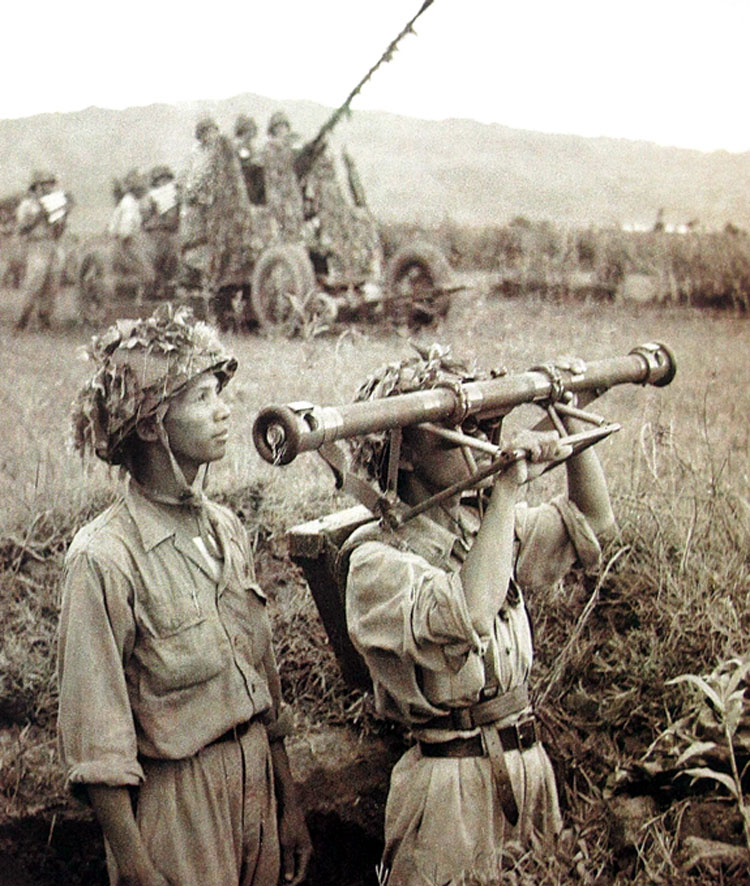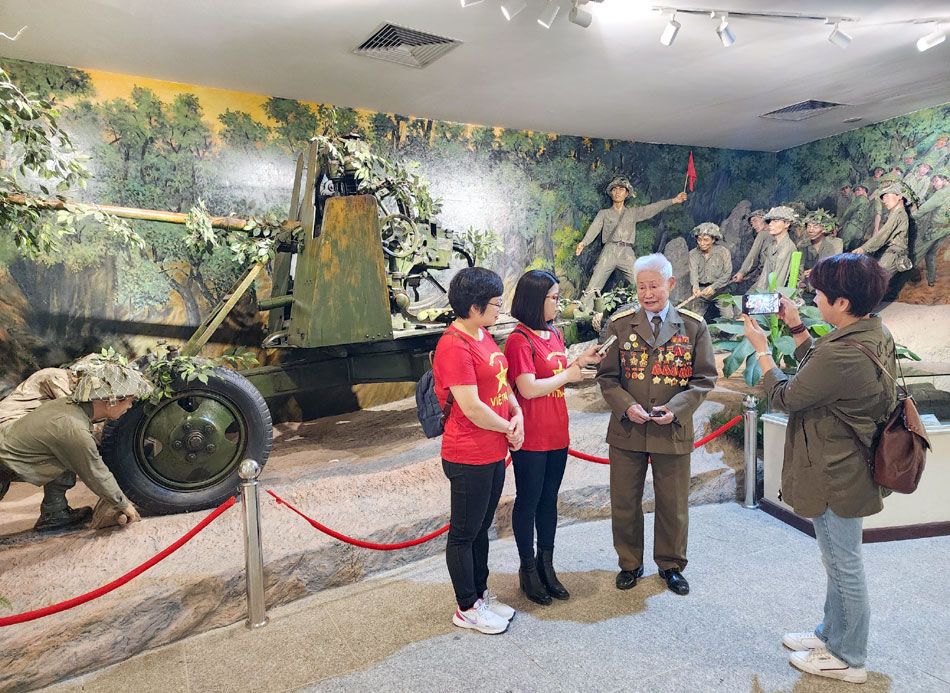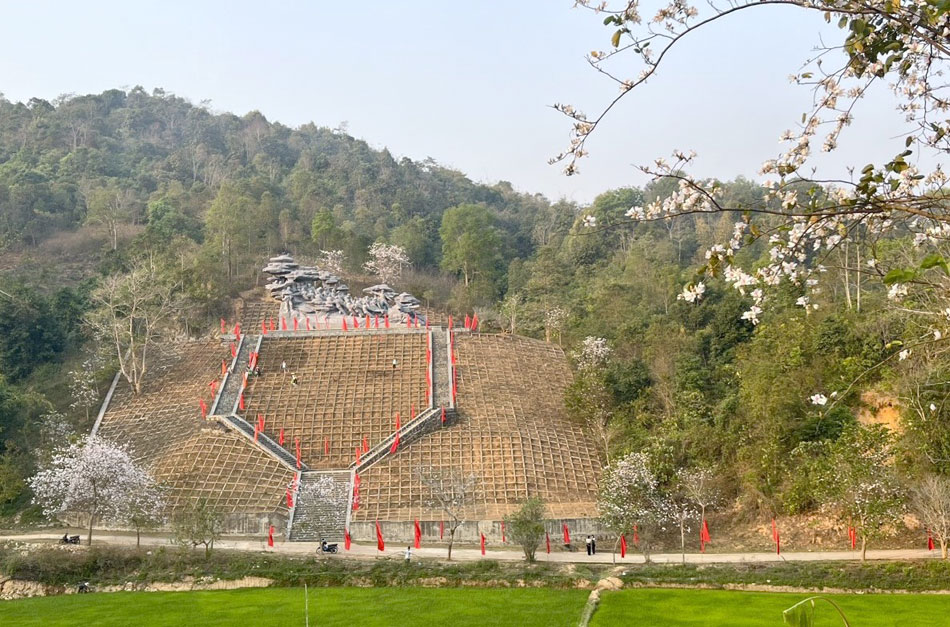According to historical archives, on March 14, 1954, when the fog had mostly lifted, an enemy’s reconnaissance aircraft flew close to the position of the 815th Anti-Aircraft Artillery Company. Around 8:30 am, a series of shots hit the airborne target, the enemy plane caught fire, and crashed into an area about 500m from the company’s position, witnessed firsthand by our troops. Cheers echoed throughout the forest. The front command had commended the and awarded a flag to the anti-aircraft artillery unit for their first achievement.

Officers and soldiers of the 383rd Anti-Aircraft Artillery Battalion (367th Regiment) engaged in the Điện Biên Phủ Campaign. Archived photo
Recalling the moment of deploying the artillery into position, Điện Biên soldier Phạm Đức Cự from the 394th Battalion, 367th Anti-Aircraft Artillery Regiment, said that on March 14, 1954, the 394th Battalion began towing the cannons from Nà Nhạn through the Tha Phu Sông mountain range (1,150m above sea level), along a route of about 12km of continuous ups and downs.
The mission of the 394th Battalion at that time was to control the western airspace, extending more than 5km from Độc Lập down to the Hồng Cúm airfield area; to destroy and prevent enemy aircrafts from attacking, and prevent airdrops to French troops at the Điện Biên Phủ battlefield. Together with the 383rd Battalion, the 367th Anti-Aircraft Artillery Regiment holding down positions in the eastern airspace, the 394th Battalion formed a pincer strategy controlling the entire airspace, protecting the troops on the grounds.

Điện Biên soldier Phạm Đức Cư recounts the story of anti-aircraft artillery to the younger generation.
"When enemy aircraft flew at an altitude above 2,000m, out of our range, we wouldn't fire. If they descended to around 2,000m or 1,500m, within our range, we would focus on destroying them!", Phạm Đức Cư said.
Following the principle of "strike firmly, advance firmly" set by the campaign command, our troops were ordered to withdraw the artillery to the original assembly points twice, despite all the difficulties in transportation, not to mention the enemy's constant attempts to sabotage.
On the night of January 25, 1954, our heavy artillery was brought into combat positions near enemy strongholds and ready to open fire. However, at this time, it was discovered that the French forces had also significantly reinforced their troops and weapons at Điện Biên Phủ, so the strategy had to be changed from "strike quickly, win quickly" to "strike firmly, advance firmly". It was during this withdrawal that artilleryman Tô Vĩnh Diện made the courageous sacrifice, wedging his own body against the cannon’s foot to prevent it from falling into the ravine at Chuối slope.
.jpg)
Điện Biên soldier Nguyễn Hữu Chấp recounts historical stories.
While the engineers and infantry cleared the way, the artillery units worked hard to build fortifications. The 367th Regiment chose Point 630 as the location for the command post. This was a hill near the 383rd Battalion, about 3km from the Him Lam stronghold. Standing on this hill, one could look over the entire Điện Biên valley and observe clearly the enemy's positions.
Thanks to close coordination with other branches in the Điện Biên Phủ campaign, our anti-aircraft artillery bravely fought and obtained outstanding results. On the morning of March 14, 1954, the 815th Company shot down the first French plane. Over the next 5 days, the 367th Regiment continued to shoot down 14 enemy planes and damaged 25 others.
Điện Biên soldier Nguyễn Hữu Chấp, captain of the 82mm mortar platoon, 290th Company, 166th Battalion, 209th Regiment, 312th Brigade, added: "At first, the French didn't know we had anti-aircraft artillery, so they entered the battle very aggressively. The enemy planes came in formations, each with 3 aircrafts, 3 formations equalling 9 aircrafts, and they would come one in these three formations one after another after one was destroyed. But once our anti-aircraft artillery opened fire and the enemy realised, they didn't dare to be as aggressive as before. At that time, the anti-aircraft artillery greatly supported the infantry, without which the situation would have been very challenging!"

The site of the manual artillery cannon transportation in Nà Nhạn Commune, Điện Biên Phủ City during March 1954.
The war may have ended 70 years ago, but the legend of the anti-aircraft artillery – the dread of the French army at Điện Biên Phủ - continues to be passed down in historical records and stories recounted by Điện Biên soldiers to today's younger generation.
Today, the Monument to the manual transportation of artillery cannons at the site of the manoeuvre, to the side of National Highway 279 (in Nà Nhạn Commune, Điện Biên Phủ City), stands as a symbol of victory, of patriotism, and of the determined will of the Vietnamese military and people under the skilful leadership of the Party and President Hồ Chí Minh in the resistance wars against foreign invasion, all for the independence and freedom of the Fatherland.





.jpg)




.jpg)

.jpg)
.jpg)
.jpg)
.jpg)
.jpg)
.jpg)
.jpg)
.jpg)
.jpg)
You have 500/500 characters left
Please enter 5 or more characters!!!